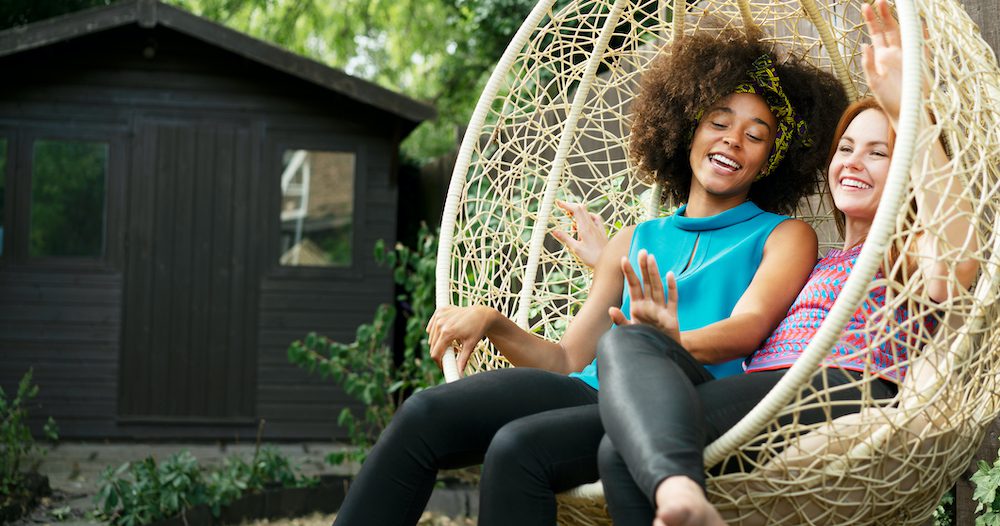
Tim Robberts / Getty Images
You probably know a wicker chair when you see one—but is it the same thing as rattan? Or what about rush, raffia, or cane?
These airy woven materials are having a moment, and it dovetails nicely with warmer weather as thoughts turn toward outfitting our decks and patios.
“These natural fibers and subtle textures are popular now in home furniture—and wicker has always been just right for outdoor living,” notes Karen Gray-Plaisted of Design Solutions KGP.
Sustainability and the added benefit of lightness are two more reasons homeowners are drawn to these materials.
“They’re much less heavy—sometimes half the weight of their traditional counterparts—which makes them easy for one person to move, says Darla DeMorrow, author of “Organize Your Home With SORT and SUCCEED.”
To help you tell the differences among the materials, here’s a little bit about six woven terms and some shopping advice for adding each to your home this season.
Rattan

Wayfair
Tropical rattan is a vinelike palm plant that’s native to Australia, Asia, and Africa and is a close relative of the palm leaf, says Anna Brockway, co-founder and president of Chairish. “It’s popularly used in seating, but rattan is also ideal for accents like drink tables and headboards,” she adds.
“Rattan comes from a fibrous plant that’s similar to bamboo, and it’s often confused with wicker because a lot of wicker furniture is made with rattan fibers,” says Gray-Plaisted.
Rattan is favored for both furniture and baskets due to its strength. It’s also a popular material in trays, as seen here. This piece ($27, Wayfair) is hand-woven for extra charm, and it wipes clean with a damp cloth.
Rush

Target
Rush is a natural fiber that’s gathered into long strands that are woven and then typically seen on chair and bench seats.
“Rush is interesting because it’s actually durable twisted paper—and it’s a nice contrast to have a seat with this material on tall traditional wooden dining or desk chairs,” says Drew Henry of Design Dudes.
Sometimes called bulrush or cattail, the Shakers embraced rush weaving in their designs. Rush’s main appeal is its durability, which is why it’s often the chosen fiber for stools and chairs. This 29-inch pick ($52, Target) features solid oak construction and a convenient footrest.
Raffia

Serena & Lily
Like rattan, raffia also comes from palm leaves but it’s much softer to the touch and sports a very fine weave.
“Raffia is made from sun-dried palm fronds and generally has a more ribbonlike, seagrass quality to it,” says Brockway.
You’ll often find baskets, hats, tote bags, sandals, and rugs crafted from delicate raffia, though it’s also made into decorative tabletop accents like placemats and coasters.
“And raffia can be used as wallpaper and wrapped around coffee, dining, and accent tables,” she adds.
This chic console ($1,298, Serena & Lily), which also comes in natural and soft-gray tones, is an example of the wrapped raffia technique. The frame has been covered with raffia by hand and then coated with a clear lacquer for a sleek finish.
Cane

Pottery Barn
“Cane is rattan’s cousin since it comes from the same plant, but it’s a thinner material because it’s been stripped from the palm,” says Henry. You’ll also know cane by its telltale octagonal shape.
“Cane is from the outer portion of the rattan palm, and it’s generally more pliable and more lightweight than rattan,” adds Brockway.
The cane work on this smart buffet ($1,499, Pottery Barn), which also comes in a black finish, is woven by hand, giving it an airy feel.
You can store books, dishes, or table linens on the two deep shelves behind the cabinet doors—and there are two useful cord cutouts in the back in case you want to house electronics.
Grass cloth

Etsy
If you’re looking for a subtle yet stunning texture for your walls, grass cloth is ideal. This natural material is made from a wide variety of fibers—including hemp, jute, seagrass, bamboo, and raffia—that are glued to a rice paper backing.
Give grass cloth a try on your walls with this peel-and-stick version (from $7, Etsy). It’s made from water-based inks, and it’s easy to apply—just soak in water and press smoothly to your walls.
Wicker

Amazon
Wicker is a little different from the rest in that it refers to a style of weave, while the others are actual fibers. Lots of wicker pieces are rattan-based, but you can also find synthetic wicker weaves, like this sweet chair set ($169, Amazon) made from resin—and you can’t beat the price for two .
The post What Is Rattan, Rush, Raffia? A Wild Guide to Woven Furnishings appeared first on Real Estate News & Insights | realtor.com®.
No comments:
Post a Comment